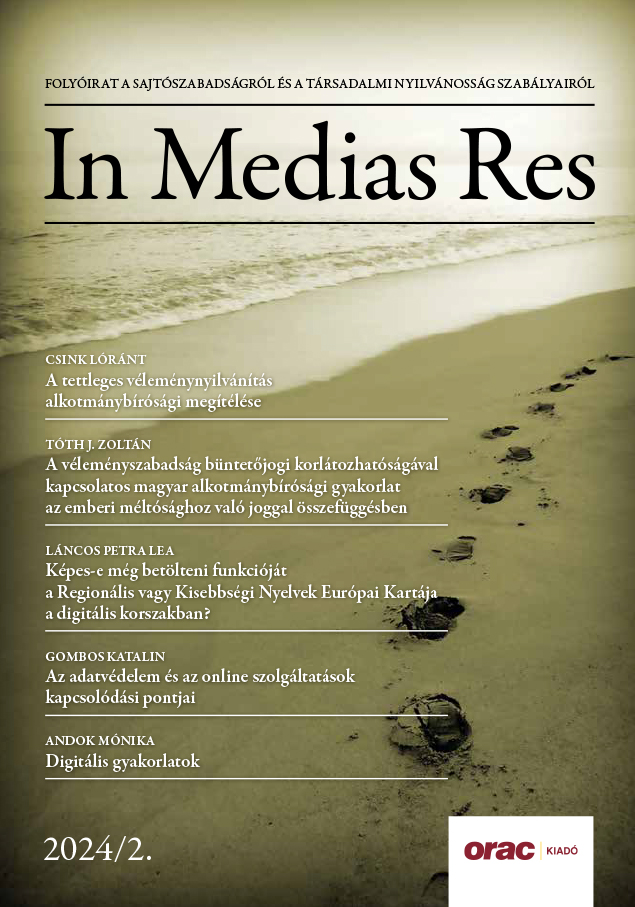Digital practices
A framework for media-related actions: praxis theory
DOI:
https://doi.org/10.59851/imr.13.2.5Keywords:
praxis theory, social shaping of technology theory, technology acceptance modelAbstract
Technological innovations in network communication, mobile internet and touch screens, as well as internal content developments of the Internet at the beginning of the 21st century, made it possible for users to appear on online platforms not only as content consumers or producers, but also to perform actions in the online space in relation to digital media. The aim of the study is to present the new media theory related to the change, the so-called praxis theory. The text discusses the sources of praxis theory both within media studies and among related disciplines. In addition, the study proposes a kind of practice typology in relation to online platforms, referring to them as simple and complex practices. The text also provides examples to present these practices. It then touches on the question of what aspects in human communities’ members consider whether to apply a digital practice or not. And this question leads us to models of critical technology research and technology acceptance.
References
Ahearne, Caroline et al.: Touch-screen technology usage in toddlers. 101(2) Archives of disease in childhood (2016) 181–183., https://doi.org/10.1136/archdischild-2015-309278
Andok Mónika: Mi, a média. In Aczél Petra (szerk.): Műveljük a médiát! Budapest, Wolters Kluwer, 2015, 15–38.
Andok Mónika: Médiahatások. In Aczél Petra (szerk.): Műveljük a médiát! Budapest, Wolters Kluwer, 2015, 97–132.
Andok Mónika: Digitális média és mindennapi élet: konvergencia, kontextus, közösségi média. Budapest, L’Harmattan, 2016.
Austin, John L.: Tetten ért szavak. A Harvard Egyetemen 1955-ben tartott William James előadások (ford. Pléh Csaba). Budapest, Akadémiai, 1990.
Balogh Csaba – Dragon Zoltán – Pusztai Bertalan: Viselhető eszközök a szegedi egyetemisták körében. ME.dok, 2021/3., 69–84.
Balogh István – Karácsony András: Német társadalomelméletek. Témák és trendek 1950-től napjainkig. Budapest, Balassi, 2000.
Bossen Bucknell, Christina – Kottasz, Rita: Uses and Gratifications Sought by
Pre-Adolescent and Adolescent TikTok Consumers. 21(4) Young Consumers (2020) 463–478., https://doi.org/10.1108/YC-07-2020-1186
Boyd, Danah: It’s Complicated: The Social Lives of Networked Teens. New Haven, Yale University Press, 2014.
Couldry, Nick: Theorising Media as Practice. 14(2) Social Semiotics (2004) 115–132., https://doi.org/10.1080/1035033042000238295
Couldry, Nick: Media, Society, World: Social Theory and Digital Media Practice. Cambridge, Polity, 2012.
Couldry, Nick – Hepp, Andreas: The Mediated Construction of Reality. Cambridge, Polity, 2017.
Davis, Fred D.: Perceived Usefulness, Perceived Ease of Use, and User Acceptance of Information Technology. 13(3) MIS Quarterly (1989) 319–339., https://doi.org/10.2307/249008
Dusek Tamás: A számszerűsített ember: az önszámlálás szociológiája. Statisztikai Szemle, 2021/4., 389–391., https://doi.org/10.20311/stat2021.4.hu0389
Felkai Gábor: Jürgen Habermas. Budapest, Áron, 1993.
Gárdos Judit – Kovács Éva – Vajda Róza: Önszociológiák? Új kihívások a kvalitatív módszereket alkalmazó kutatásokban és archiválásukban. In A. Gergely András et al. (szerk.): Kultúra, közösség és társadalom. Tanulmányok Tibori Timea tiszteletére. Budapest, Társadalomtudományi Kutatóközpont – Magyar Szociológiai Társaság, 2020, 123–140.
Guillory, John: A médiafogalom eredete (ford. Berze András et al.). Apertura, 2012. tavasz, https://bit.ly/3CTKcuX.
Guld Ádám: „A sztárok mindenhol ott vannak.” A 360 fokos ismertség jellemzői egy kvalitatív közönségkutatás tükrében. Médiakutató, 2020/1., 79–92.
Guld Ádám: Sztárok, celebek, influencerek a médiában megszerezhető ismertség és hírnév természete. Kolozsvár, Erdélyi Múzeum Egyesület, 2021.
Habermas, Jürgen: A kommunikatív cselekvés elmélete (ford. Ábrahám Zoltán et al.). Budapest, Gondolat, 2011.
Harlow, Summer – Harp, Dustin: Collective Action on the Web: A Cross-Cultural Study of Social Networking Sites and Online and Offline Activism in the United States and Latin America. 15(2) Information, Communication & Society (2012) 196–216., https://doi.org/10.1080/1369118X.2011.591411
Katz, Elihu – Blumler, Jay G. – Gurevitch, Michael: Uses and Gratifications Research. 37(4) The Public Opinion Quarterly (1973) 509–523., https://doi.org/10.1086/268109
Keviczky László: Az internet rövid története. In Kondor Zsuzsanna – Fábri György (szerk.): Az információs társadalom és a kommunikáció-technológia elméletei és kulcsfogalmai. Budapest, Századvég, 2003, 211–229.
Lupton, Deborah: The Quantified Self. Cambridge, Polity, 2016.
MacKenzie, David – Wajcman, Judy (szerk.): The Social Shaping of Technology (Second Edition). Buckingham, Open University Press, 1999.
Papacharissi, Zizi – Mendelson, Andrew: Toward a New(er) Sociability: Uses, Gratifications, and Social Capital on Facebook. In Stylianos Papathanassopoulos (szerk.): Media Perspectives for the 21st century. London, Routledge, 2011, 212–230.
Pólya Tamás: A médium mint cselekvési közeg. Médiumelméleti nézőpontváltás a technológiai determinizmus után. Replika, 2011/3., 51–73.
Schatzki, Theodore R.: Social Practices: A Wittgensteinian Approach to Human Activity and the Social. Cambridge, Cambridge University Press, 1996., https://doi.org/10.1017/CBO9780511527470
Schatzki, Theodore R. – Knorr Cetina, Karin – Savigny, Eike von (szerk.): The Practice Turn in Contemporary Theory. London, Routledge, 2005., https://doi.org/10.4324/9780203977453
Silverstone, Roger: Médiaerkölcs: A médiapolisz felemelkedése (ford. Kerényi Szabina). Budapest, Napvilág, 2010.
Szijártó Zsolt: Sokszínű médiavilágok. A mindennapi élet és a médiakutatás antropológiai dimenziói. Budapest, Gondolat, 2022.
Szűts Zoltán: Online. Az internetes kommunikáció és média története, elmélete és jelenségei. Budapest, Wolters Kluwer, 2018.
Williams, Robin – Edge, David: The social shaping of technology. 25(6) Research Policy (1996) 865–899., https://doi.org/10.1016/0048-7333(96)00885-2
Downloads
Published
How to Cite
Issue
Section
License
Copyright (c) 2024 Mónika Andok

This work is licensed under a Creative Commons Attribution 4.0 International License.


